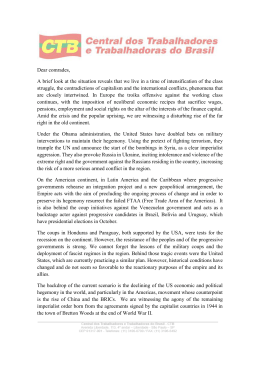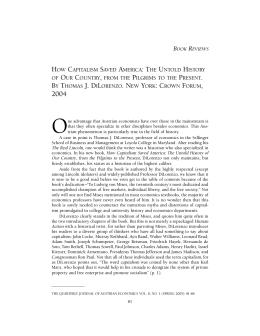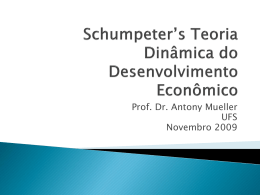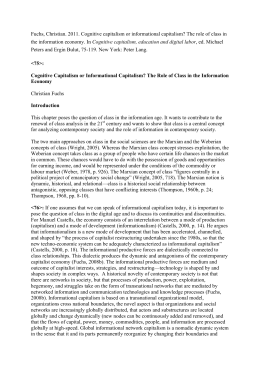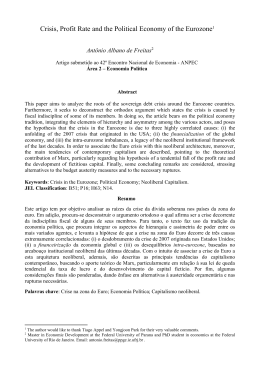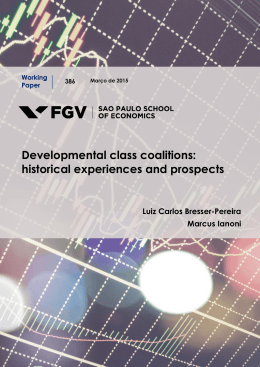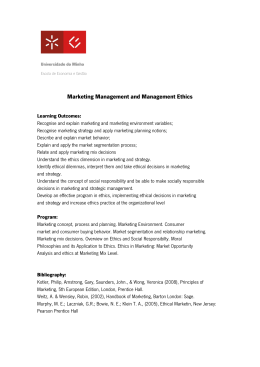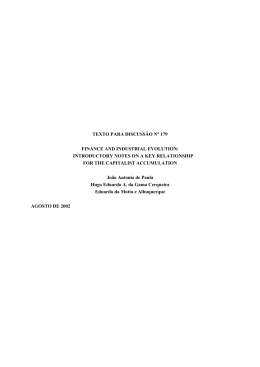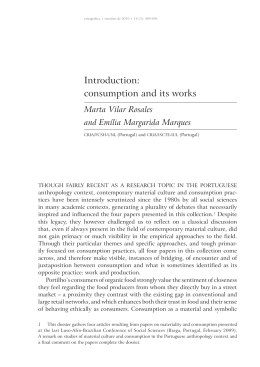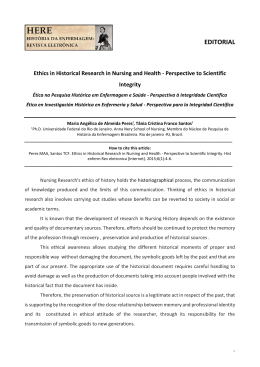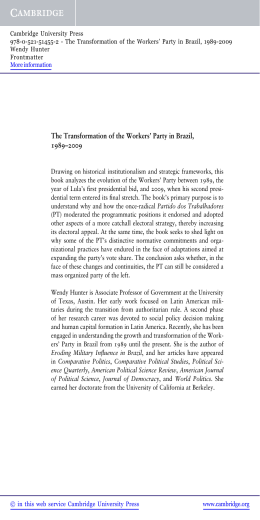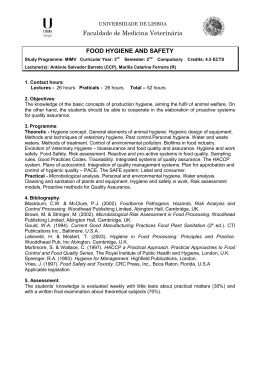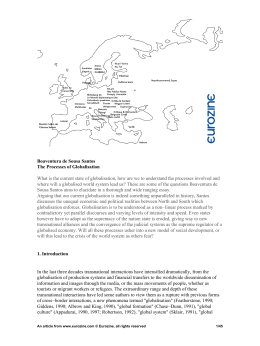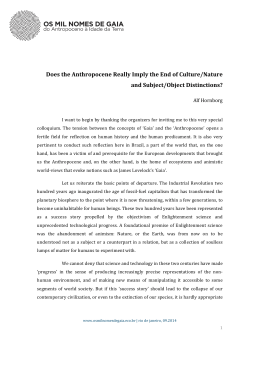Chapter 3† The Idea and Ideal of Capitalism* Gerald Gaus 1. Capitalism, Business and Ethics Consider a stylized contrast between medical and business ethics. Both fields of applied ethics focus on a profession whose activities are basic to human welfare. Both enquire into obligations of professionals, and the relations between goals intrinsic to the profession and ethical duties to others and to the society. I am struck, however, by a fundamental difference: whereas medical ethics takes place against a background of almost universal consensus that the practice of medicine is admirable and morally praiseworthy, the business profession is embedded within the framework of firms in a capitalist market economy, and for the last century and a half there has been sustained debate about the moral and economic justifiability of such an economy. To be sure, even under socialism there might be an “ethics of socialist managers,” and there would be some overlap between such an ethic and contemporary business ethics. Nevertheless, many of the characteristic problems of business ethics — e.g., what are the obligations of a corporation to its shareholders? — arise only in the context of a private property-based market economy. This raises a deep problem for business ethics: can one develop an account of ethical practices for an activity (i.e., business) while ignoring that the context in which this activity occurs (i.e., capitalism) is morally controversial? It is as if the work in medical ethics proceeded in the midst of widespread disagreement whether medicine was a good thing. Another way of thinking about the problem is: if one teaches business ethics, does this commit you to accepting that business can be ethical? And doesn’t this commit you to accepting that capitalism is justifiable?1 I suspect that this is a serious problem for many teachers of business ethics. Many were trained in academic philosophy, and within academic philosophy there are many who think — or at least suspect — that capitalism is basically unjust, or perhaps that only a greatly modified capitalism would be acceptable. The great economist, John Maynard Keynes articulated a view that is probably shared by many teachers of business ethics: For my part I think that capitalism, wisely managed, can probably be made more efficient for attaining economic ends than any alternative system yet in sight, but that in itself it is in many ways extremely objectionable. Our problem is to work out a Forthcoming in The Oxford Handbook of Business Ethics, edited by Tom Beauchamp and George Brenkert. † * I would like to thank Matt Zwolinski and the editors for the very helpful comments and criticisms 2 social organisation which shall be as efficient as possible without offending our notions of a satisfactory way of life.2 Indeed, many teachers and students of business ethics may not even incline as far as Keynes in thinking that capitalism can be made acceptable: in the end, Keynes was more a liberal reformer than a radical critic of capitalism. If the practice of business ethics is embedded in a capitalist economic system, students and teachers of business ethics should have an appreciation of what a relatively pure form of capitalism would look like. We can then begin to think about what would be required for its justification. Knowing that, we will then be in a position to reflect on whether we think there can be truly ethical business practices. If, after seeing what a pure form of capitalism would be, and what would be required for its justification, a student or teacher of business ethics concludes that such justification is not to be had, then her task is basically Keynes’s: to determine what, if any, alteration of this system retains the important benefits of capitalist business while conforming to her notion of “a satisfactory way of life.” Perhaps, reflecting on contemporary versions of capitalism she will decide that the current versions depart from the pure form, and because of that they are consistent with her notion of a satisfactory way of life; then again, it is possible that contemporary capitalism is objectionable just because it departs too much from the pure form. My task in this chapter is to sketch what I see as the elements of a pure form of capitalism, and to indicate some of the ways that proponents of capitalism have sought to justify these elements. The rather vague idea of “capitalism” is better grasped if we analyze it into distinct elements. And each element might be justified in different ways. As the reader will see, I believe that once we reflect on the elements of capitalism we will see that Keynes and many others have woefully underestimated its power as an ideal way to organize economic — and indeed many social — relations. However, my main aim is not to defend capitalism as an ideal, but to analyze capitalism into its constitutive elements. This will not only allow us to better understand the context in which business occurs, but it will help the reader to better identify just what aspect of capitalism, if any, offends her notion “of a satisfactory way of life.” This chapter, then, is not so much an essay in business ethics as it is an essay on the foundations of the very practice of business and business ethics — the idea of a capitalist economic order. 2. Private Property Maximally Extensive Feasible Property Rights: Capitalist Ownership Classical debates about the justifiabiity of capitalism, and especially the contrast between capitalism and communism, focused on the right to private property. John Stuart Mill (a defender of a modified version of capitalism) and Karl Marx (the most famous critic of all) supposed that capitalism is essentially defined by a system that relies on private property rights, and so they thought that the rejection of capitalism just is the rejection of private 3 property. “Communism is the positive abolition of private property,” wrote Marx.3 The complete abolition of private property has rarely been advocated. In Plato’s ideal republic, it is true, the ruling class were to live under complete communism — including communism of wives — but that is an extreme view indeed.4 Even Soviet Communism recognized personal private property in the form of consumer goods such as clothes, household items, and books. Perhaps, then, capitalism requires private property in non-personal goods — we might think that capitalism is characterized by the private ownership of capital goods (i.e., goods required for the production of other goods). Although there is something to this, throughout almost all of human history capital goods such as tools and farm equipment have been privately owned, yet we wouldn’t want to say that capitalism has been the dominant mode of production throughout all human history.5 Just what is the relation between capitalism and private property? The ideal of capitalism — that is, a pure version of capitalism — is characterized by maximally extensive feasible property rights along two different dimensions. The first dimension concerns the extent of an individual’s ownership right or, as philosophers often put it, the extent of the bundle of rights that make up a person’s property. Most scholars today conceive of property in terms of a set of rights that might vary. For Alf to have full private property rights over P, Alf must have:6 • The right to use P as he wishes so long as this is not harmful to others or their property; • The right to exclude others from using P; • The right to manage: Alf may give permission to any others he wishes to use P, and determine how it may be used by them; • The right to compensation: If someone damages or uses P without Alf’s consent, Alf has a right to compensation for the loss of P’s value from that person. • The rights to destroy, waste or modify: Alf may destroy P, waste it or change it. • The right to income: Alf has a right to the financial benefits of forgoing his own use of P and letting someone else use it. • Immunity from expropriation: P (or any part of P) may not be made the property of another or the government without Alf’s consent, with the exception of a few items such as taxation. • Liability to execution: P may be taken away from Alf by authorized persons for repayment of a debt. • Absence of term: Alf’s rights over P are of indefinite duration. • Rights to rent and sale (transfer rights): Alf may temporarily or permanently transfer all or some of his rights over P to anyone he chooses. 4 To say that someone who holds these rights over P has maximally extensive feasible property rights over P is to say that his control over P is as complete as possible (the maximal claim) given the like control of others over their property (the feasibility claim). If we drop the feasibility requirement we can give Alf an even more extensive control over P: he might have the right to use his property in ways that harm others, or has no liability to execution. But this increase in his control would limit others’ control over their property. If Alf has the right to use his property in ways harmful to others, their use of their property will be impaired. If Alf is free from liability to execution, he can avoid paying compensation when he damages the property of others. So we can think of the above as approaching the maximally extensive control of Alf over P consistent with the like control of others over their property. Maximally extensive feasible property rights is part of an ideal, pure conception of capitalism. Real world economic systems, even those that we would all agree are appropriately deemed “capitalist,” may limit Alf’s control over P by limiting, or even removing, some of these rights. Zoning laws limit the uses to which Alf may put his property; historical district regulations limit his rights to destroy, waste or modify his residence; business licensing laws limit his ability to transfer his property; laws setting a maximum interest rate limit his right to an income. Sometimes, however, real-world systems actually expand these rights. A long-established public policy has been to limit the extent to which consumers can claim rights to compensation against harm from certain public utilities; thus the utilities have less liability than other property owners.7 All these are rightly seen as ways of qualifying full capitalist ownership of some people. It is clear, though, that as these qualifications accumulate, we are apt to wonder whether the remaining property rights are sufficiently extensive to provide the basis for capitalism. And certainly some of these rights are more fundamental to capitalism than others. The rights to use, to exclude, to income, to modify, to manage, to transfer, to compensation and immunity from expropriation are basic to a capitalist order. An economic system that is based on some qualifications on them may still be recognizably capitalist: one that drastically curtails any of them over a wide range of property begins to loose its capitalist character. A system that does not generally recognize the rights to income or to transfer, for example, may be said to have a sort of private property, but not capitalist property. The right against expropriation raises deep questions about the justifiability of taxation. Non-consensual takings of property limit or abridge this right; if such takings are extensive, the resulting system will be far from the capitalist ideal.8 As John Locke insisted, if government may legitimately take away people’s property without their consent, “this would be in effect to leave them no Property at all.”9 Given this, the most extreme capitalist position is “anarcho-capitalism,” which maintains that, because all taxation is non-consensual, government is inherently illegitimate.10 Locke took a more moderate view. Though he held that government may not raise taxes without the people’s consent, insofar as a legitimate legislature rests on the consent of the governed, taxation approved by a representative legislature does not constitute an expropriation, and so is not a violation of property rights.11 Thus the famous rallying cry of the American Revolution — “No taxation without 5 representation!” — expresses a strong commitment to capitalist property rights. Only if government is organized in a certain way can its taxes, which take a citizen’s property, be legitimate.12 Maximally Extensive Feasible Property Rights: What Can be Owned One dimension along which the ideal of capitalism endorses maximally extensive feasible property rights is, then, the extent of the bundle of rights one has over P. The other dimension concerns the range of objects13 over which one can have property rights. The capitalist ideal is to extend as far as possible the range of things that are privately owned. Of course under the capitalist ideal, consumer and productive goods are privately owned. So too are natural resources. Recently advocates of capitalism have argued that many of our environmental problems stem from the absence of private property rights over such resources. Many environmental problems concern what are called “common pool resources,” which are characterized by (1) relatively open (“public”) access and (2) private consumption. Clean air and fresh water are common pool resources: they are accessible to everyone but consumed privately. The “tragedy of the commons” arises in situations in which individuals (or groups) make individually rational decisions about how much of the relevant resource (e.g., water, air) to consume that, collectively, leads to the over-harvesting of that resource and depleting its sustainable capacity.14 Pollution is a prime example of a common pool problem: over-use of the air’s ability to dissipate waste gasses leads to the depletion of that ability. When goods remain in the common pool, if some restrain their current consumption (e.g., fish less) while others do not, those who restrain themselves will not only end up with less today, but very likely will have no more in the future: those who do not restrain themselves may well overharvest the resource, depleting future stocks. If so, no one has an incentive to restrain themselves today and all will over-harvest. Most of our worst resource depletion problems — the ability of the atmosphere to absorb carbon dioxide, fresh air, fresh water, fisheries, coral reefs, wild animals — stem from lack of private property rights. When a resource is privately owned, the owner will be confident that she will benefit from her restraint on present use: she will reap less today but she will gain the benefit — future sustainable yields. As David Schmidtz has convincingly argued, only if resources are taken out of the common pool will depletions be minimized. As he tellingly puts it, “leaving goods in the common practically ensures their destruction.”15 When dealing with resources that cannot be renewed such as petroleum, capitalist ownership induces efficient pricing (see section 3, below), which in turn encourages both search for additional supplies and alternative technologies. Advocates of the capitalist ideal thus have sought to extend as far as feasible the range of objects subject to private property rights. This includes maximal rights over one’s body and labor, so that one is free to sell any services to others that do not harm third parties (again, one’s use of one’s property does not uncontroversially extend to harmful uses). Although Marx sometimes saw private property as characteristic of capitalism, at other times he stressed that capitalism’s truly distinctive feature was the “commodification of labor”: that labor itself is a commodity to be bought and sold like any other good.16 This 6 “commodification” of labor and services is embraced by capitalism: defenders of capitalism not only endorse the sale of labor in the usual contexts, but may also support—even strongly support — more controversial applications such as the right to sell sexual services in the form of prostitution, sell pornography, create clubs with strippers, and so on. The terms “sex industry” and “workers in the sex industry” expresses this “commodification” of sexual services. Indeed, many friends of capitalism push the “commodification” even further, arguing for property rights in body parts, and thus for the right to sell parts of one’s body such as a kidney17 — or, more radically, any body part. The upshot of this conception of capitalism is a “permissive society”: in “competitive capitalism … the businessman will make money by catering to for whatever it is people wish to do — by providing pop records, or nude shows, or candyfloss.”18 At the extreme, this leads some advocates of capitalism to allow that an individual may transfer the property over himself to another, becoming a slave or a source of many body parts for research and transplantation.19 Justifying Capitalist Property Rights The space of capitalist property. I have been describing a regime of maximally extensive feasible property rights; as Figure 1 shows, there are numerous regimes of property that lie between such a regime (point A) and communism (point D): Maximal A C Range of Objects that may be property B D Minimal Minimal Maximal Extent of the Right of Owership Figure 1 One might speculate that, say current American capitalism is closer to point C than to A, the capitalist ideal: the range of things that can be owned is quite extensive (though certainly not maximal — think of the absence of property over heroin, certain sexual services, and kidneys), but ownership rights are qualified in numerous ways (licensing regulations, environmental regulations, health and safety rules, and so on). On the other hand, John Stuart Mill seemed to support a system closer to B: something like full property rights over what can be owned but significant limitations on what should be owned. For Mill, the justification of private property — that people deserve the fruits of their labor — does not apply to land: “No man made the land. It is the original inheritance of the whole species.”20 To justify a non-pure regime of capitalist property rights, then, is to justify a system of property rights somewhere in the neighbourhood of point A. To justify the capitalist ideal is 7 to justify the sort of maximally extensive feasible property rights at A. Although we cannot even begin to fully survey the arguments that have been advanced to justify such extensive property rights, it will help to get some idea of why advocates of capitalism have thought property rights approaching point A can be justified. I consider briefly two important lines of justification advanced by political philosophers (I turn to economists in section 3). Self-ownership. Perhaps the most influential justification holds that (1) to be a free person is to have maximally extensive feasible property rights over oneself and (2) there is some mechanism that allows these extensive self-ownership rights to yield extensive rights over objects in the world. For Locke, one’s property is not just one’s “estates” but one’s “life,” “liberty,” and “person.”21 In this sense we are self-owners, and our ownership over parts of the world is an extension of our self-ownership. For Locke, when a person mixes his labor (which is his property) with unowned parts of the world, he can extend his property in his person to include those parts of the world. This type of view was by no means unique to Locke. As Stephen Buckle shows in his study of the natural law theories of property, Hugo Grotius, Samuel Pufendorf, and Locke all insisted on an intimate connection between a person’s rights and what “belongs” to her. This idea of what belongs to a person or her “suum” concerns a set of “essential possessions”: life, limbs, and liberty. Thus understood, says Buckle, the suum is “what naturally belongs to a person because none of these things can be taken away without injustice.” 22 Now, crucially, natural law theorists held that one’s suum could be — indeed, if we are to survive, must be — extended into the world. As Buckle says, concerning Locke, “[t]he property in one’s own person thus has a dynamic quality, in that it needs to grow to survive — it requires the acquisition of certain things. The suum must be extended — ‘mixed’ with things — in order to be maintained.”23 Thus by extending one’s suum into the external world — in Locke’s theory, by mixing one’s labor with parts of the world — external private property in goods is generated. External ownership involves property rights over things that are as extensive as property rights over oneself: they are an extension of the attributes of personhood itself. If the self-ownership argument is to justify the sort of extensive capitalist property rights we have been analyzing, (1) it must be shown that the extension process applies a suitably wide range of objects and (2) that these new property rights are characterized by the full bundle of capitalist rights. Both of these tasks look daunting. As Buckle notes, at the heart of self-ownership theories such as Locke’s was the idea that our right of self-ownership is inalienable: we have property in our own person, but no right to destroy or waste it.24 But if one’s property rights over one’s self constitutes less than full capitalist property, it is hard to see how one’s extension of this right of self-ownership creates full capitalist property rights: the extended property rights would be more complete than the property right on which they are based. Moreover, if the point of the extension of one’s suum is to provide for our maintenance, then it seems that this process could not justify property rights that would ultimately be harmful to us, such as property rights over heroin or alcohol. To be sure, some advocates of the self-ownership view have insisted that a pure self-ownership doctrine would 8 accord us full capitalist property rights over our body and labor.25 An implication of this position would be that others would have a right of execution over your body for purpose of compensation and non-payment of debts — a radical view. Agency Justifications. A more adequate justification of maximally extensive property seeks to derive them from the very idea of agency. Loren Lomasky, for example, argues that persons, understood as pursuers of projects, have a natural and important interest in possessing things: Persons…have a natural interest in having things. The relation of having is conceptually more basic and not to be confused with a property right. It amounts to the actual ability to employ some object in the furtherance of one’s designs and does not presuppose the existence of any structure of rights. Having I and enjoying property rights in I are conceptually and empirically distinguishable….However, these are not two unrelated concepts. It is because of a person’s interests in having objects that there is an interest in being accorded property rights.26 Thus, as Lomasky understands them, property rights protect one’s possession of things. “Property rights demarcate a moral space within which what one has is marked as immune from predation.”27 Such morally secure possession is required for successful project pursuit. The crucial task for the agency justification is to move from a general argument that some property is necessary for agency to a defense of maximally extensive property rights. The agency argument has an easier time than self-ownership accounts in showing that our rights of ownership should approximate full property rights (our first dimension of capitalist property rights): agency requires that one be able to control parts of the world as part of one’s projects, and full capitalist property maximizes control. But can it also be shown that the agency justification leads to the desirability of maximal property rights over the other dimension — the things over which one can have property? This looks more dubious. The key, it would seem, is to show that (1) agency is a great, perhaps the supreme value and (2) to limit what parts of the world a person may own, or what services she may sell, always to some extent limits her agency and so (3) it takes a extremely strong case, in terms of competing values, to justifiably set a limit on what can be owned, or what services can be sold. Thus, for example, an advocate of the agency justification may object to John Rawls’s suggestion that one’s interest in agency is adequately advanced by a system that grants private property over personal items but prohibits it over productive goods.28 Such a socialist system prohibits “capitalist acts between consenting adults”29 — and that looks like a significant limitation on the types of projects that one is free to pursue. 3. Capitalism and Markets Markets and Efficient Property: Full Capitalist Property Rights To fully understand why capitalism endorses maximally extensive property rights we need to turn from philosophic justifications to the analysis of the market and efficiency. In his classical paper on “The Problem of Social Cost” R.M. Coase showed that, regardless of the 9 initial distribution of property rights, if there are no transaction costs, free exchange in the market yields an efficient outcome.30 Consider an example. As we all know, there is a great demand for solar panels in the West; environmentalists, those concerned about global warming, and those interested in national energy independence all are urging increased use of solar power. Now the production of solar panels requires polysilcon, but manufacturing polysilcon produces toxic waste. In western countries this waste is recycled; in China, however, recycling technologies are not well developed, and recycling is not required by law.31 Waste is either stored or, after minimal reprocessing, released into the environment. It is estimated that to recycle the waste would increase the cost of Chinese polysilcon by somewhere between 50 to 400%. It is disputed how great the resulting pollution is, but it is safe to say that enough waste leaks on to adjoining land to severely curtail agriculture on surrounding farms. Suppose, as does Coase, that we ignore transaction and bargaining costs; and simply focus on the Polysilcon Factory and say, the group of Affected Farmers. The Polysilcon Factory clearly produces what economists call a negative externality on the Affected Farmers: its productive activity negatively impacts their livelihood. Now if the Polysilcon Factory does not take this negative impact into account it has an incentive to produce polysilcon up to the point where its marginal costs equal its marginal benefits: that is, up to the point where its costs for producing another ton of polysilcon equals the profits of doing so. (That this is so is a standard axiom of economics.) If the Polysilcon Factory is at a level of production such that the benefits of producing another ton of polysilcon exceed the total costs of producing that unit, it clearly has an incentive to produce that additional ton; if it is at the point where the total costs of producing another ton of polysilcon exceed the benefits of producing that unit, it clearly has an incentive not to produce that ton. But the problem for society is that at the point at which the Polysilcon Factory’s marginal costs equal its marginal benefits, the total social costs will have exceeded the total social benefits. This is because the Polysilcon Factory does not take into account the costs imposed on the Affected Framers; if it considers these costs in its calculations, it would have ceased production at a lower level of output (at an extreme, zero). To see this better, let us assume some figures. Suppose that a Polysilcon Factory would incur a one-time cost of $500,000 to build an improved storage facility that would not leak on to neighboring properties: suppose such a facility would last 20 years, so the yearly cost is roughly $25,000. Now assume that the pollution causes a collective loss of $40,000 a year to the Affected Farmers. Even if there is no law against the pollution, an efficient result can still be achieved: the Farmers can pay the Factory $25,000 a year to build the improved facility. They will be $15,000 a year better off, and the factory will be no worse off (if they pay $26,000, both will be better off than in the current situation). It is important that this “theorem” applies regardless of how the property rights are divided between the two parties. An efficient outcome can be reached whether the Factory has a right to pollute or the Farmers have a right that it not pollute. Suppose that there is indeed a law against pollution, but to totally stop pollution would require a much larger expenditure, say $10,000,000; suppose the Factory could not afford to pay this and would close down. Assume that the Farmers still 10 suffer a total loss of $25,000 a year and that the Farmers have the right to bring suit against the Factory. Now it is efficient for the Factory to pay the Farmers something more than $25,000 a year not to bring suit. This would be better for both the Farmers and the Factory than shutting down the Factory. According to Coase, then, in the absence of transaction and bargaining costs, parties to activities with negative externalities will agree to some efficient allocation of resources regardless of the initial distribution of property rights. Coase’s theorem challenges one of the main principled justifications for government activity. In the absence of a perfect scheme of property rights that fully internalizes costs and benefits (i.e., an economic actor reaps the full benefits, but also pays the full costs, of his activity), it has been widely argued that government action is necessary to regulate the “market failure” that results from externalities (when an actor imposes costs on another that are not considered in his calculations). But Coase argues that, at least ideally, market transactions can solve the problem of externalities and get us to efficient outcomes (though the actual costs involved in negotiation, etc. may preclude this, and then government action may be required as a second-best strategy). But — and this is the important point — if markets are to approach efficient outcomes in which people are compensated for externalities, people must have extensive rights to make agreements. Restrictions on to what they can agree to — what trades they can make, what aspects of their rights they can transfer to others, how they can use their property, and so on — will undermine efficiency and the possibility of mutual benefit. Suppose that the Factory is doing $1,000,000 damage to the Farmers, but that strict enforcement of the pollution code would raise the price of Factory’s polysilcon by 200%, which would drive it out of business. It would obviously be mutually beneficial for the Factory and the Framers to agree to, say, a payment to the Farmers of $1,500,000 a year: both would be better off than if the factory closed. If such agreements are precluded — if the parties cannot trade their rights in these ways — then the efficient outcome may not be possible. Thus we see how full capitalist ownership rights are conducive to efficiency — and “efficiency” is simply a term for mutual benefit. Unless each is free to trade her rights as she sees fit, opportunities for mutually beneficial exchanges will be blocked. Markets, Mutual Benefit, and Mutual Respect The account I have been stressing conceives of markets as arenas of mutual benefit. The idea that exchange is generally mutually beneficial is at the heart of what we might call that capitalist view of social life (and most of modern economics). In contrast, in the eyes of many opponents of capitalist markets, market exchanges are what game theorists call “zerosum” transactions: for every gain by one party, there is a corresponding loss by another. The market is seen as a realm of dog-eat-dog competition: some win by devouring others, but the devoured lose. For every one who eats there is someone who is eaten. In the words of a former French prime minister, “What is the market? It is the law of the jungle, the law of nature.”32 Capitalism rejects this conflict-ridden view of social life and the market. If I possess two bottles of beer, and you posses two slices of pizza, an exchange of a slice of 11 pizza for a bottle of beer will make us both better off.33 As Adam Smith saw it, our propensity to “truck, barter and exchange one thing for another”34 is at the root of mutual benefit, and the growth of wealth. Give me that which I want and you shall have this which you want, is the meaning of every such offer; and it is in this manner that we obtain from one another the far greater part of those good offices which we stand in need of. It is not from the benevolence of the butcher, the brewer, or the baker, that we expect our dinner, but from their regard to their own interest….Nobody but a beggar chooses to depend chiefly on the benevolence of his fellow-citizens.35 In commenting on this passage Stephen Darwall stresses that, though certainly it is about mutual advantage, it presumes far more than mere self-interested agency. Smith stresses that exchange relations presuppose agents who conceive of each other of having distinct points of view, which demand respect. “Smith evidently thinks of exchange as an interaction in which both parties are committed to various normative presuppositions, for example, that the exchange is made by free mutual consent, that neither party will simply take what the other has….Both parties must presume that the other is dealing fairly.”36 Market transactions are built on a foundation of trust and a type of mutual respect: without that, we are apt to invade for gain (a true zero-sum interaction) rather than trade for mutual gain. As Smith famously shows, markets both rely on, and provide the main impetus to, the division of labor. If someone is a butcher, another a brewer, and another a baker, an immensely greater amount of food and drink is available than if each is her own butcher, brewer, and baker. According to David Hume, this is the very essence of society: “By the partition of employments, our ability encreases.”37 Indeed, for Hume market relations are even more basic than property or justice: the rules of property and justice evolve out of market relations based on the division of labor. As cooperation proceeds, conventions arise about the terms of our cooperative interactions — hence the genesis of our principles of justice. Are Market Exchanges Always Beneficial? A fundamental claim of capitalism, then, is that markets respect full private property rights and allow for mutual benefit among independent agents. We have been assuming that each of the parties to the exchange has full information about what they are exchanging. Economists generally assume that both parties to an exchange are equally informed; only recently has there been a sustained interest in how asymmetric information can affect market transactions.38 To the extent that one party does not know what he is buying, we can no longer suppose that market exchanges are truly mutually beneficial. Of course classical exponents of the market economy insisted that mutual gain through markets presupposed the absence of fraud and force (recall the idea that markets are based on trust and a sort of mutual respect), but the problems of asymmetric information run deeper. A related problem is asymmetric bargaining power. One of the main justifications for labor laws regulating hours and factory conditions in the early part of twentieth century was 12 that employers and workers had asymmetric bargaining power, so that workers were forced to accept disadvantageous bargains. This line of analysis is more complex and controversial than it first appears. Hardly any bargains are made from equality of bargaining power, yet the fact that some need the bargain more than others does not show that the exchange is not mutually beneficial. On the other hand, in extreme cases unequal bargaining power can undermine the moral legitimacy of market outcomes. As Robert Nozick, a staunch defender of capitalism argued, “a person may not appropriate the only water hole in a desert and charge what he will. Nor may he charge what he will if he possesses one, and unfortunately it happens that all the water holes in the desert dry up but his.”39 Under these conditions an offer of a glass of water for all your property would be a coercive offer: an offer that exploits one’s bargaining power and simply cannot be refused.40 Instead of mutual advantage we have a sort of exploitation of those in great need. Thus far we have been considering the conditions under which an individual market transaction is genuinely mutually beneficial. But it might be objected that a series of market transactions, each of which is unobjectionable, may have an outcome in which some (i.e., the workers) have no real choices, and so their freedom and self-ownership is undermined. Nozick appears to deny this: Consider the following example. Suppose that there are twenty-six women and twenty-six men each wanting to get married. For each sex, all of that sex agree on the same ranking of the twenty-six members of the opposite sex in terms of desirability of marriage partners: call them A to Z, and A΄ to Z΄ respectively in decreasing preferential order. A and A΄ voluntarily choose to get married, each preferring the other to any other partner. B would most prefer to marry A΄, and B΄ would most prefer to marry A, but by their choices A and A΄ have removed these options. When B and B΄ marry, their choices are not made nonvoluntary merely by the fact that there is something else they would rather do. This other most preferred option requires the cooperation of others who have chosen, as is their right, not to cooperate. … This contraction of the range of options continues down to Z and Z΄, who face a choice between marrying the other or remaining unmarried.41 Nozick argues that Z and Z΄ are still free to choose whether or not to get married, despite their extremely restricted range of options. After all, the others have simply chosen other partners, a decision that was fully within their rights. Z and Z΄ are not unfree simply because no one has chosen them. Nozick goes on to insist that this same reasoning applies to workers who may face extremely restricted employment options: their freedom and self-ownership have not been undermined by the legitimate choices of others. Suppose a business ethics teacher at a small college complains that she is not free to move to some other position because no one wishes to give her a job — Nozick insists she is perfectly free, the problem is that her services simply are not desired by any other institution. G. A. Cohen disagrees: he believes that a series of legitimate choices can lead to an outcome that undermines the freedom of some and so some are forced to accept offers.42 Suppose that each person in a community acts within their rights to erect a fence on their property, preventing others from crossing it. Now also suppose that Alf is surrounded by such fences, and can no longer leave 13 his property. Betty makes an offer: half his wealth for free passage through her property. Do we really want to say that, as a result of a series of legitimate choices, Alf’s self-ownership and freedom have not been compromised? It seems that they have been. A defender of markets must, I think, show that the overall effect of markets, far from radically decreasing options, is to increase them, providing a greater range of choice. 43 To be sure, just what we mean by a greater range of choice is open to various interpretations: it might mean simply how many options a person has, how many options a person values, the breadth of options (not simply a lot of options to do basically similar things), and so on. These are difficult issues in the philosophy of freedom. However, on almost any interpretation, modern capitalist-like market economies have astronomically increased people’s range of options. Consider Eric Beinhocker’s comparison of two tribes: the Yanomamö, a tribe living along the Orinoco River between Brazil and Venezuela, and the New Yorkers, a tribe living on Hudson River along the border of New York and New Jersey. The Yanomamö have an average income of $90 a year, the New Yorker $36,000: But it is not just the absolute level of income that makes the New Yorkers so wealthy: it is also the incredible variety of things their wealth can buy. Imagine you had the income of a New Yorker, but you could only spend it on things in the Yanomamö economy. If you spent your $36,000 fixing up your mud hut, buying the best clay pots in the village, and eating the finest Yanomamö cuisine, you would be extraordinarily wealthy by Yanomamö standards, but you would still feel far poorer than a typical New Yorker with his or her Nike sneakers, televisions and vacations in Florida. The number of economic choices the average New Yorker has is staggering. The Wal-Mart near the JFK Airport has over 100,000 different items in stock, there are over 200 television channels offered on cable TV, Barnes and Noble lists over 8 million titles, the local supermarket has 275 varieties of breakfast cereal, the typical department store offers 150 types of lipstick, and there are over 50,000 restaurants in New York City alone. 44 Beinhocker points out that the 400-fold difference in income does not even begin to estimate the difference in options; the New Yorker, he estimates, has an order of 1010 more choices — an astronomical number.45 And with these consumer choices come occupational, educational, and religious ones as well. When we compare capitalist modern market economies with simple non-market economies (and Soviet-type planned economies), what is striking is not simply the difference in the absolute level of wealth, but in the range of options — the jobs one can perform, the goods one can consume, the lives one can have. Markets and Efficiency: the Extent of Property As we have already seen in the case of common pool resources, extending the range of things that can be privately owned is of fundamental importance if our aim is to ensure efficient sustainable use. Efficiency is also nearly always enhanced when services are privately rather than publicly provided. There is evidence of the greater efficiency of private over public ownership in, among other things, airlines, banks, municipal bus services, cleaning services, debt collection, fire protection, hospitals, housing insurance claims processing, military 14 aircraft repair, ocean tanker maintenance, preschool education, garbage collection, removal of abandoned vehicles, slaughterhouses and weather forecasting.46 Hayek provides one of the most compelling arguments for extending as far as possible the range of things subject to private ownership. As Hayek understands a modern society, each individual has her own projects and plans (think again of the agency justification in section 2); whether she is successful depends on whether she can mesh her plans with those of others.47 If plans come into constant conflict, people will find their aims and projects frustrated. Two things are needed for this meshing. First, there must be settled rules of conduct that allow each to anticipate the actions of others: repeated interventions by government to change regulations and the rules of the market undermine our ability to anticipate others. Second, however, we require knowledge: we need to know what others are doing. If we are to efficiently pursue our own goals we must have an idea of whether the resources necessary for our plans are being demanded by others, whether others will be interested in the outputs of our plans and projects, and so on. But how can we know that? Modern society is literally composed on hundreds of millions of people; the knowledge required for meshing the plans of these great societies is of an incredible magnitude. The economic problem of society is thus not merely a problem of how to allocate “given” resources — if “given” is taken to mean given to a single mind which deliberately solves the problem set by these “data.” It is rather a problem of how to secure the best use of resources known to any of the members of society, for ends whose relative importance only these individuals know. Or, to put it briefly, it is a problem of the utilization of knowledge which is not given to anyone in its totality.48 The problem is this: each of us has both personal and local knowledge not generally available to others, and yet the success of our plans often depends on knowing the personal and local knowledge of others. Personal knowledge consists of one’s knowledge of one’s own plans and goals. Local knowledge is “the knowledge of the particular circumstances of time and place. It is with respect to this that practically every individual has some advantage over all others because he possesses unique information of which beneficial use might be made, but of which use can be made only if the decisions depending on it are left to him or are made with his active cooperation.”49 I wish to employ my local knowledge to exploit those possibilities of which I know. But for me to successfully do this requires that I know about events in far off places that might affect my plans: what do others want, what alternative uses do they have for resources, what local new possibilities do they see that I don’t? How can I possibly know all this? Now — and here is Hayek’s great contribution — this knowledge of remoter events is conveyed by the price system. The relative prices for goods do not tell us why goods are wanted, or why they are in short supply: it is a summary measure conveying just the crucial information — that others want the good, or that they are having a hard time getting hold of enough. “The marvel [of the market] is that in a case like that of a scarcity of one raw material, without an order being issued, without more than perhaps a handful of people knowing the cause, tens of thousands of people whose identity could not be ascertained by months of investigation, are made to use the material or its products more 15 sparingly; i.e., they move in the right direction.”50 The market, then, sums up the local and personal knowledge of actors across the world, and converts it into the crucial information that each of us must have so that we can use our own local and personal knowledge to efficiently satisfy our aims. If, though, the market is to convey as much information as possible about the plans, resources, and opportunities, as many resources as possible must be subject to the price mechanism. To take something out of the market limits the spread of information about it, impairing the effectiveness of plans throughout the market. Consider the use of central city streets. In most large metropolitan areas, streets in the central business district are jammed: it is very difficult for anyone to make reasonable progress in their journeys. It is the perfect case where plans fail to mesh: in fact, they often gridlock. The system does not tend to promote efficient outcomes: the increased demand for city streets does not sufficiently raise the price, which would induce people to use alternative methods of transport, or simply avoid the central city. To be sure, as congestion becomes horrible, there is some movement to other modes of transport or avoiding the city center, but it is very difficult to gauge what are the relative costs or benefits. The problem is that use of city streets is not a tradable good, and so no price emerges. This could be remedied by a system in which those who placed a higher value on using central city streets could pay others not to use them. Transactions costs, though, would be extraordinarily high in this case. A more realistic proposal that would tend toward efficiency would be to auction a limited number of permits to use central city streets. Those who place more value on using the streets would pay more and, if these permits could be traded, those who lost out on the auction could buy permits from others: we would then have a useful social signal about how much value people place on using non-jammed streets. Moving yet further away from a market solution, cities might follow London in placing a fee on using city center streets. This limits congestion, but the price does not provide much information about how much people value using the streets, since it is set by a central authority and not by market interactions. The “Commodification” Objection to a Market with Extensive Property Rights “The market,” Cass Sunstein tells us, “is typically the sphere for use.”51 The things bought and sold on the market are typically commodities. But humans also have a wide range of non-use values such as friendship, life, health, enlightenment. They are not only different goods, they are valued in different ways: friends — true ones, at any rate — do not value each other because of their use to each other. Or, according to Elizabeth Anderson’s somewhat different analysis, sometimes “higher” and “lower” valued goods cannot really be compared, and if they cannot be compared, they cannot be traded, for the market “commensurates” goods: it scores all goods on a common, monetary, scale of value. Two goods are incomparable in intrinsic worth if they are not candidates for the same mode of valuation. One good is of incomparably higher worth than another if it is worthy of a higher mode of valuation than the other — worthy of love, awe, respect or honor beyond what is owed to persons in general, worthy of respect beyond the consideration owed to animals, worthy of consideration beyond mere use….[O]ne 16 way to express this difference in demands is to prohibit tradeoffs between states of affairs concerning the goods that express a lower kind of valuation for the higher good than it merits.52 Thus, argue critics, because markets turn all goods into mere tradable commodities, they violate our sense of value. When thinking about these matters, it is important to be careful how we relate the idea of “price” (or “economic value”) to our wider notions of what is valuable. Consider two “commodities” that in some ways appear of widely different types: Norman Rockwell’s 1943 “Rosie the Riveter” and an endowed chair in Philosophy. Rockwell’s painting has sold for almost five million dollars; a fully endowed chair in Philosophy costs between three and four million. If price is meant to sum up the total values of the “Rosie the Riveter” and a chair in philosophy, and if to accept the market is to accept that “Rosie the Riveter” is, overall, more valuable than a philosophy professorship, then the market certainly would do violence to my values. There is more to values than that. But it is not — or at least it shouldn’t be — a claim of friends of market that price fully captures what we mean by the “value” of two “commodities.” Ideally, the market price of X indicates the amount of resources the marginal buyer is willing to allocate to secure X. I can, and do, hold that the philosophy professorship is more valuable than “Rosie the Riveter,” and in so saying I do not claim that there has been a market failure. We do not all place the same value on each commodity: that is precisely why trades take place. It is our differences, not agreements, in valuations that underlie market exchange. If we all valued everything to the same extent, no one would trade her goods for anyone else’s. As Hayek stressed, it makes no sense to say that the market price is the value of anything; market prices are the result of our differences in how we value goods.53 The mistaken idea that goods in the market that have equal prices must have equal value inherent in them, and so the market exchange somehow expresses — or purports to express — the true value of goods, is at the heart of the Marxist criticism of markets (see further section 4).54 4. The Hierarchical, Profit-maximizing Firm The Master-Servant Relation It might seem that once we have described a market based on maximally extensive property rights we have completed our task of characterizing the capitalist ideal. Not so. In his Principles of Political Economy — the most influential economic text of the nineteenth century — John Stuart Mill sketches an alternative to capitalism that embraces both private property and markets. Mill endorsed the private ownership of firms, but not firms in which some were hired and were required to obey the instructions of the owners — the “master.” Hitherto there has been no alternative for those who lived by their labour, but that of labouring either each for himself alone, or for a master. But the civilizing and improving influences of association, and the efficiency and economy of production on a large scale, may be obtained without dividing the producers into two parties with hostile interests and feelings, the many who do the work being mere servants under the command of the one who supplies the funds, and having no interest of their own 17 in the enterprise except to earn their wages with as little labour as possible…. [T]here can be little doubt that the status of hired labourers will gradually tend to confine itself to the description of workpeople whose low moral qualities render them unfit for anything more independent: and that the relation of masters and workpeople will be gradually superseded by partnership, in one of two forms: in some cases, association of the labourers with the capitalist; in others, and perhaps finally in all, association of labourers among themselves.55 As workers become better educated and more public-spirited, Mill argued, the master/servant relation characteristic of the capitalist firm will be replaced by a regime of worker cooperatives: worker-owned firms that compete in the market. The idea was that workers would be collective owners of the firms and democratically decide important strategic matters, though-day-to-day operations would still be directed by a manger instructing workers what to do — but a manger that could be dismissed by the workers. Thus the worker cooperatives were privately held firms in a competitive market economy without the master-servant relation (in which the owners are masters and the workers simply hired servants). Unfortunately for this view, the worker cooperative movement barely outlived Mill; worker cooperatives appear to have succumbed to the greater efficiency of capitalist firms based on the master-servant relation.56 Hierarchy and Efficiency Why did Mill’s hope for the future — firms owned by the workers and, ultimately, managed by them, succumb to traditional capitalist firms in which, either, the owner managed the firm and hired workers as his “servants,” or (see below) the owners hired managers, who in turn instructed the workers about what to do, when to do it, and so on? As we have seen, Coase had a fundamental impact on our thinking about markets, property and efficiency. Another of his papers fundamentally changed our thinking about “The Nature of the Firm.” 57 Coase agrees with Mill: the “master and servant” relation is fundamental to the capitalist firm (it is widely thought that this relation is at least partly constitutive of capitalism).58 This, of course, is a hierarchical, authority, relation: those who own (or at the behest of the owners, who manage) make the decisions about what is to be produced, how, by whom etc. The job of the workers is to do as they are instructed by their “boss.” Coase and his followers show that organization via such an authority relation reduces transaction costs. Transactions organized through the market and its price mechanism entail, for instance, negotiating costs and information costs: we must find out who is selling a product, whether we wish to pay his price, and so on. Typically these costs are not so great as to make market exchange inefficient; however in some cases the negotiations would be quite costly. Suppose that one is building a new computer. One might buy all the components in the market, but perhaps one’s aim is to design a new computer. This would involve a new motherboard unit, a video display that works well with it, effective power sources, and so on. Now these new units must work well together, and this may require constant cooperation by the individual design teams (focusing on the motherboard, display, etc) as they are building the unit. If so, it may greatly 18 reduce transaction costs to have a central coordinator who directs each specialist team and their activities, giving them design parameters so that the designs work well together. And so one may organize a hierarchical firm. The firm, then, is a way to decrease some transaction costs. In this sense the hierarchical firm is an engine of efficiency.59 The “Socialist” Character of the Capitalist Firm The division of labor in the market is based on individual producers and consumers, each contracting with each other; one’s reward is directly based on one’s production of what others want. The division of labor in the firm is very different. It is based on a central coordinator — the boss — who decides the relevant targets, and then designs systems that divide up tasks in order to achieve the goals. Of course the boss may seek input and feedback from her subordinates, but this is up to her. Those with authority make plans and instruct the “servants” how to go about implementing them. The values within the firm are in many ways the opposite of the values between participants in the market: whereas the latter stress independence, contract, and reward based satisfaction of demand, the former stresses the values of leadership, teamwork (directed by leaders), tasks based on instruction from above, and reward based on the boss’ evaluation of the subordinates’ usefulness to the firm. It is interesting that the values within the firm were attractive to many communists. N. I. Bukharin and Evgenii Preobrazhensky sought to organize all of society as one large factory. They wrote in their ABC of Communism: We must know in advance how much labour to assign to the various branches of industry; what products are required and how much of each it is necessary to produce; how and where machines must be provided. These and similar details must be thought out beforehand, with approximate accuracy at least; and the work must be guided in accordance with calculations.... Without a general plan, without a general directive system, and without careful calculation and book-keeping, there can be no organization. But in the communist social organization, there is such a plan.60 Just as a factory manager seeks to organize and plan production, so too, it was thought, must communist planners organize and plan production for the entire economy. Thus early communists had great regard for capitalist techniques of production within enterprises; it was the “anarchy” of the market that provoked their deepest ire.61 Because most people in capitalist societies spend their lives within large corporations, in non-profit organizations such as universities, or in government service, we arrive at the surprising conclusion that most people in capitalist societies spend their lives in organizations whose values are in many ways more “socialist” than “capitalist.” This is an important theme in Hayek’s work. In large organizations subordinates expect to be rewarded according to their merit: they were given tasks to perform and if, on some set of criteria, they performed well, they merit a higher pay. As Hayek points out, this is very different than reward in the market: “Reward for merit is reward for obeying the wishes of others in what we do, not compensation for the benefits we have conferred upon them by doing what we thought best.”62 In the market one’s reward does depend on how much others benefit from your 19 action; and a good deal of luck may be involved in this. An entrepreneur may gain because she was in the right place and the right time, and so able to perceive a way to satisfy others’ wants. In the market two entrepreneurs may have tried equally hard, done everything in their power, and one entirely fail and the other be a great success. It is not the case that such luck is simply about the way a “deliberate gamble” works out: the luck may be that the entrepreneur’s local situation was such that she had possibilities of gain that were simply unknowable by others.63 Because most of us spend most of our time in organizations not informed by market values, when we come to politics — where market outcomes are often the subject of debate — we tend to apply our “socialist” (i.e., non-market) values to market outcomes. For example, in contemporary political philosophy one of the most influential doctrines of distributive justice is that property should track the distinction between “choice and chance”: although one should be held responsible for one’s choices, one should not be held responsible for what results from mere brute chance.64 Distributive justice, it is said, should compensate people for bad brute luck.65 This claim resonates with all of us who have spent our life within large organizations: if things go wrong for us and it was through no fault of our own, then we insist that this does not detract from our merit, or the rewards we are due from our bosses. “It was simply bad luck” is a relevant reply in one’s end-of-the-year review. But, as Hayek points out, this makes no sense in the market, which in many ways runs by brute luck. Entrepreneurs are confronted by options many of which are not of their own devising; efficiency is promoted by them taking advantage of this “brute luck” (a sort of local knowledge) to satisfy additional wants and aims.66 To “compensate” entrepreneurs for their bad luck (not having the same local knowledge as others) would undermine the very core of the market as a device for generating information. For the market to function, differential local knowledge must crucially enter into an entrepreneur’s profits. In Hayek’s eyes the upshot of this is a certain moral instability of capitalism: most people in capitalist economic systems have moral views about justice and distribution that they apply to the market, and are destructive of the very economic prosperity on which all depend. What is the Aim of the Capitalist Firm? Ever since Marx it has been said that a constitutive characteristic of capitalism is the profitmaximizing firm.67 Given that the capitalist ideal is based on full property rights, this cannot be literally true: a full owner can do anything he wishes with his property. Think of the familiar story of the Christmas Carol.68 The firm of Scrooge and Marley was profitmaximizing with a vengeance: the only thing that Scrooge and Marley ever cared about was maximizing their profit. On the other hand, the firm at which Scrooge apprenticed as a lad, run by Mr. Fezziwig, moderated profit maximization with special kindness to its employees. Now it does not seem that Fezziwig’s firm departs from any of the core commitments of capitalism: Fezziwig owned his firm and competed in the market. Still there is something right about identifying Scrooge and Marley as the “more” capitalist firm. After all, Fezziwig cannot go too far in ignoring profitability: if he runs his firm simply as a way to be kind to 20 employees, it will fail. If Fezziwig’s costs are too high he will be out-competed —consumers will not buy his product; if his returns are too low, he will not be able to loan funds from banks. (Indeed, he does go out of business in the 1951 movie version.) So we might think of Fezziwig as compromising the firm’s profitability with his concern for his employees.69 Scrooge and Marley can run their firm simply and purely as a way to maximize profit, and that will not cause it to fail. Market competition does reward firms that excel at earning profits. In contrast to Dickens’s Victorian-era capitalism, in which firms are often privately owned by those who manage them, modern-era large capitalist firms are largely owned by shareholders, and their shares are very often publicly traded. And they are managed by nonowners, or at most by partial owners. This raises a host of difficult issues about what the aim of such firms should be. 70 Instead of owner-managers, we are confronted by a world composed of principals and agents: the managers of the firm are agents of the principals, the shareholders. This leads to a host of possible complications and problems: agents may pursue aims not approved by principals, and which are not in the principals’ interests — a possibility that simply did not arise in owner-managed firms.71 We cannot explore these difficult issues here, but one thing seems clear: in anything approaching the capitalist ideal, the shareholders own the firm, and it is their wishes and interests that should guide the agents. Capitalism, we have seen, is based on full ownership: if the firm is not managed according to the wishes or interests of the shareholders, their ownership rights are abridged. Apart from contractual obligations and basic market norms of fair-dealing (see section 3), the interests of employees as such — simply as “stakeholders” in the firm — are not ultimate aims of mangers in an ideal capitalist order. Of course the shareholders may desire that such stakeholders be accorded consideration: like modern Fezziwigs, they may compromise some profit in order to improve the lot of their non-owning stakeholders. But when firms are publicly traded, conveying this information to prospective investors may be costly and difficult. In capitalist economies there is a presumption that managers are the agents of the shareholders: firms that have included non-owners among their principals run the risk of misleading potential investors about their ownership rights. Profit But what is profit? In his important essay on the concept of profit, James Child remarks that there is no accepted understanding of the concept.72 One remarkable feature of debates about profit is that to friends of capitalism “profit” has strongly positive connotations, while to critics it is a strongly pejorative term. Hayek argues that intellectuals, from Aristotle to Bertrand Russell and Albert Einstein, all misunderstand the idea, a misunderstanding summed up by the slogan “Production for use, not for profit.”73 This common attitude to profit derives from seeing economics as an engineering problem: knowing what people want and what resources are available, the problem is to maximize the production of goods to maximize the satisfaction of wants. But, as we saw in section 3, Hayek stressed that economics is precisely the study of how wants are satisfied when no one knows everyone’s 21 wants, no single person knows all the available resources, or the possible ways to satisfy these (largely unknown) wants. The “search for profit” by the entrepreneur is the probing of the entrepreneur “beyond known uses and ends” in order to best satisfy the “multiplicity of human ends.”74 In contrast, for Marx “profit and wages remain in inverse proportion”: profits come out of the possible wages of laborers.75 For Marx the key to profit under capitalism is that in the market the exchange value of a commodity is determined by its cost of production, in particular by the amount of labor it takes to produce a good.76 Because capitalist markets treat the ability to labor as itself a commodity, it too has an exchange value — the amount of labor it takes to produce a unit (e.g., an hour) of the ability to work (or, we might say, “labor power”). The key to understanding capitalism, Marx insists, is that labor power is “a source not only of value, but of more value than it has itself.”77 The price of a unit of (say, a day’s) labour power is the amount of labor it takes to produce it; suppose it take four hours of labor to produce a day’s worth of labor power. This would include all the labor that goes into the worker’s food for the day, his clothes for the day, supporting his family for the day, and so on. But the worker labors ten hours a day and so creates ten hours of value; the price of his labor power was four hours of labor. The six hours of surplus value — that which the worker creates above and beyond the cost of producing his ability to work for the day — is the source of profit. Hence profit directly comes out of what the worker produced and, in other systems of production, might have constituted his reward for his work. For Marx, profit is a sort of theft. Child proposes that these different attitudes toward profit derive from the two opposed attitudes toward exchange that we observed in section 3: exchange as a zero-sum versus positive sum, cooperative, interaction. If exchange is viewed as zero-sum, then one party’s profits must come out of the other party. If we focus on the firm and the sale of labor power, the capitalist’s profits must be someone’s loss—the workers’. Where else could profits come from? In contrast, on the positive sum view, “One makes profits by benefiting those one transacts with, while benefiting oneself….”78 Capitalism insists that the pursuit of profit is not only socially useful, but benefits all parties to the exchange. 5. Conclusion In this chapter I have sketched the elements of the capitalist ideal: maximally extensive property rights, efficient markets employing such rights, and hierarchical firms run in the interest of the owners. I have focused here on an ideal or pure version of capitalism: realworld systems often described as “capitalist” modify one or more of these elements. To know one’s attitude to capitalism is to know one’s evaluation of these elements: someone who strongly supports them all is a fervent defender of capitalism. Others may advance criticisms of one or more elements, and so approve of a modified form of capitalism. As one rejects more elements, either on moral or economic grounds, one begins to move to a non-capitalist economic system. The question for teachers and students of business ethics is whether their 22 evaluation of the elements still endorses a recognizably capitalist business firm. If not, they are confronted with problem with which we began: studying the ethics of an organization embedded in a system that we ought not to have. 23 Notes Or perhaps business ethics is some sort of theory of the morally second-best: it instructs one how to act ethically in a morally unjustifiable context. Is that what business ethics does? 1 John Maynard Keynes, “The End of Laissez-Faire,” in his Essays in Persuasion (London: Macmillan, 1972), p. 294 2 Karl Marx, Economic and Philosophic Manuscripts of 1844, in Marx/Engels Collected Works (London: Lawrence & Wishart, 1975-2002), vol. 4, p. 293. Compare John Stuart Mill, Principles of Political Economy with Some of Their Applications to Social Philosophy, in The Collected Works of John Stuart Mill, edited by J.M. Robson (Toronto: University of Toronto Press, 1977), vol. 2, Book II, chap. 1. 3 Plato, The Republic, in The Dialogues of Plato translated into English with Analyses and Introductions by B. Jowett, 3rd edition revised and corrected (Oxford University Press, 1892), pp. 106ff. 4 5 On this point see Jürg Niehans, A History of Economic Theory: Classic Contributions, 1720-1980 (Baltimore: Johns Hopkins University Press, 1990), p. 143. 6 This list draws on A.M. Honoré, “Ownership” in Oxford Essays in Jurisprudence, edited by A. G. Guest (Oxford: Clarendon Press, 1961), pp. 107-47; and Frank Snare, “The Concept of Property,” American Philosophical Quarterly, vol. 9 (April 1972), pp. 200-206. For an excellent and accessible discussion, see Lawrence C. Becker, Property Rights: Philosophical Foundations (London: Routledge & Kegan Paul, 1977), chapter. 2. See Paul Finn, “Public Function — Private Action: A Common Law Dilemma,” in Public and Private in Social Life, edited by S.I. Benn and G.F. Gaus (New York: St. Martin’s Press, 1983): 93-111. 7 The now-classic work on this matter is Richard A. Epstein, Takings: Private Property and the Power of Eminent Domain (Cambridge, MA: Harvard University Press, 1985). 8 9 John Locke, Second Treatise of Government, edited by Peter Laslett (Cambridge: Cambridge University Press, 1960), section 139. Emphasis in original. 10 See David Friedman, The Machinery of Freedom (New York: Harper and Row, 1973); Murray Rothbard, “Society without a State,” in NOMOS XIX: Anarchism, edited by J. Roland Pennock and John W. Chapman (New York: New York University Press, 1978), pp. 191-207. 11 Locke, Second Treatise, section 142. On the range of anti-taxation anarcho-capitalist views, see Eric Mack and Gerald F. Gaus, “Classical Liberalism and Libertarianism: the Liberty Tradition,” in The Handbook of Political Theory, edited by Gerald F. Gaus and Chandran Kukathas (London: Sage, 2004), pp. 115-142. For a contemporary criticism of this view, see Liam Murphy and Thomas Nagel, The Myth of Ownership: Taxes and Justice (New York: Oxford University Press, 2002). I respond to some of their main claims in my “Proto-Ownership Rights and the Requirements of Justice,” Social Philosophy & Policy, forthcoming. 12 13 I use “objects” broadly here to include financial instruments, such as mortgages. See Garret Hardin, “The Tragedy of the Commons,” in his Managing the Commons, (New York: W.H. Freeman, 1977). 14 David Schmidtz, The Limits of Government: An Essay on the Public Goods Argument (Boulder, CO: Westview Press, 1991), p. 21. 15 16Karl Marx, Capital, vol. I in Marx/Engels Collected Works, vol. 35, chapter. 6. See James Stacey Taylor, Stakes and Kidneys: Why Markets in Human Body Parts Are Morally Imperative (Aldershot, UK: Ashgate, 2005). Cf. Stephen R. Munzer, “An Uneasy Case Against Property 17 24 Rights in Body Parts,” Social Philosophy & Policy, vol. 11 (Summer, 1994): 259-86. I do not mean to suggest that only friends of the capitalist ideal support such markets. Samuel Brittan, A Restatement of Economic Liberalism (Atlantic Highlands, NJ: Humanities Press, 1988), p. 1. 18 19 See Robert Nozick, Anarchy, State and Utopia (New York: Basic Books, 1974), p. 331. 20 Mill, Principles of Political Economy, book 2, chapter 2, section 6. Emphasis added. 21 Locke, Second Treatise, sections 27, 123. 22 Stephen Buckle, Natural Law and the Theory of Property (Oxford: Clarendon Press, 1991), p. 29. 23 Buckle, Natural Law and the Theory of Property, p. 171. Buckle argues for the applicability of the concept of suum to Locke's theory on pp. 168-74. See also A. John Simmons, The Lockean Theory of Rights (Princeton: Princeton University Press, 1992), pp. 226-27. 24 Buckle, Natural Law and the Theory of Property, pp. 191ff. 25 Nozick, Anarchy, State and Utopia, p. 58. 26 Loren E. Lomasky, Persons, Rights and the Moral Community (New York: Oxford University Press, 1987), pp. 120-21. Emphasis in original. 27 Lomasky, Persons, Rights and the Moral Community, p. 121. John Rawls, Justice as Fairness: A Restatement, edited by Erin Kelly (Cambridge, MA: Harvard University Press, 2001), pp. 136ff. I have in mind here Rawls’s support of “liberal (democratic) socialism.” 28 29 Nozick, Anarchy, State and Utopia, p. 163. 30 See Ronald Coase, “The Problem of Social Cost,” Journal of Law and Economics, vol. 3 (1960): 1-44. My explication follows Dennis Mueller, Public Choice III (Cambridge: Cambridge University Press, 2003), pp. 27-30. 31 See Ariana Eunjung Cha, “Solar Energy Firms Leave Waste Behind in China,” Washington Post, March 9, 2008, page A1. 32 Edouard Balladur quoted in Martin Wolf, Why Globalization Works (New Haven: Yale University Press, 2004), p. 4. For an explanation of this notion of allocative efficiency, see my On Philosophy, Politics, and Economics (Belmont, CA: Thomson Wadsworth, 2008), chap. 3. 33 34 Adam Smith, An Inquiry Into the Nature and Causes of the Wealth of Nations, edited by W.B. Todd (Indianapolis: Liberty Fund, 1981), book I, chapter 2, paragraph 1. 35 Smith, Wealth of Nations, book I, chapter 2, paragraph 2. 36 Stephen Darwall, The Second-person Standpoint: Morality, Respect, and Accountability (Cambridge: Harvard University Press, 2006), p. 47. 37 David Hume, A Treatise of Human Nature, second edition, edited by L. A. Selby-Bigge and P. H. Nidditch (Oxford: Oxford University Press, 1978), book 3, part 2, section 2, paragraph 3. 38 See Todd Sandler, Economic Concepts for the Social Sciences (Cambridge: Cambridge University Press, 2001), chapter 7. 39 Nozick, Anarchy, State and Utopia, p. 180. 40 Joel Feinberg, The Moral Limits of the Criminal Law, vol. 3, Harm to Self (New York: Oxford University Press, 1986), p. 250. 41 Nozick, Anarchy, State and Utopia, p. 263. 25 42 See G. A. Cohen, Self-Ownership, Freedom and Equality (Cambridge: Cambridge University Press, 1995), pp. 35-37. 43 See Eric Mack, “Self-ownership, Marxism, and Egalitarianism, Part II: Challenges to the Self-ownership Thesis,” Politics, Philosophy and Economics, vol. 1 (June 2002): 237-76, pp. 243ff. 44 Eric D. Beinhocker, The Origin of Wealth (Cambridge: Harvard Business School Press, 2006), p. 9. 45 Beinhocker, The Origin of Wealth, p. 9. Charles Wolff, Jr., Markets or Governments: Choosing between Imperfect Alternatives (Cambridge, MA: MIT Press, 1993), Appendix B 46 See Hayek, Law, Legislation and Liberty, vol. 1, Rules and Order (Chicago: University of Chicago Press, 1973), p. 99. 47 F.A. Hayek “The Use of Knowledge in Society,” American Economic Review 35 (September 1945), pp. 519-520. 48 49 Hayek “The Use of Knowledge in Society,” p. 522. 50 Hayek “The Use of Knowledge in Society,” p. 527. 51 Cass R. Sunstein, Free Markets and Social Justice (Oxford: Oxford University Press, 1997), p. 94. 52 Elizabeth Anderson, Values in Ethics and Economics (Cambridge, MA: Harvard University Press, 1993), p. 70. 53 Hayek, The Mirage of Social Justice, p. 76. 54 Marx, Capital, vol. 1, part I, chapter 1, section 1. 55 Mill, Principles, book 4, chapter 7, section 4. For an excellent analysis of cooperative production, see P.J.D Wiles, Economic Institutions Compared (New York: Wiley, 1977), chapter 6. See also Oliver E. Williamson’s analysis of the “Peer Group” system in The Economic Institutions of Capitalism (New York: Free Press, 1985), pp. 217ff. 56 57 Coase, The Firm, The Market and the Law, chapter 2. See, for example, Talcott Parsons’s “Introduction” to Max Weber, The Theory of Social and Economic Organization, translated by A. M. Henderson and Talcott Parsons (New York: Free Press, 1947), p. 51; Niehaus, A History of Economic Theory, p. 144; Karl Marx, Capital, chapter 14, section 5. 58 59 See Williamson, The Economic Institutions of Capitalism. 60 Nikolai Bukharin and Evgenii Preobrazhensky, The ABC of Communism, quoted in Michael Ellman, Socialist Planning (Cambridge: Cambridge University Press, 1979), p. 9. Emphasis added. See Bukharin and Preobrazhensky’s views on the “anarchy of production” in Ellman, Socialist Planning, p. 8. See also Marx, Capital, chap. 14, section. 4. 61 62 F.A. Hayek, The Constitution of Liberty (London: Routledge and Kegan Paul, 1960), p. 100. On the distinction between “option” luck and “brute” luck, see Ronald Dworkin, Sovereign Virtue: The Theory and Practice of Equality (Cambridge, MA: Harvard University Press, 2000), pp. 73ff 63 64 Dworkin, Sovereign Virtue, pp. 287ff. Whether good brute luck should be compensated for is a matter of disagreement. See Peter Vallentyne, “Self-Ownership and Equality: Brute Luck, Gifts, Universal Dominance and Leximin,” in Real Libertarianism Assessed, edited by Andrew Reeve and Andrew Williams (New York: Palgrave Macmillan, 2003): 29-52. 65 26 Indeed, believing that one’s property is deserved, Hayek says, encourages “an air of self-righteousness.” Hayek, Law, Legislation and Liberty, vol. 2, The Mirage of Social Justice (Chicago: University of Chicago Press, 1976), p. 74. 66 67 See, for example, Niehans, A History of Economic Theory, p. 144. 68 Charles Dickens, A Christmas Carol in Five Christmas Novels (New York: Heritage Press, 1939). 69 See Wiles, Economic Institutions Compared, p. 67. 70 For complexities, see Wiles, Economic Institutions Compared, pp. 69-70. On economic analyses of principal-agent relations, see Sandler, Economic Concepts for the Social Sciences, pp. 120ff. 71 72 James W. Child, “Profit: The Concept and its Moral Features,” Social Philosophy & Policy, vol. 15 (Summer 1998): 243-82, pp. 243ff. 73 F. A. Hayek, The Fatal Conceit, edited by W.W. Bartley III (Chicago: University of Chicago Press, 1988), p. 104. 74 Hayek, the Fatal Conceit, pp. 104-05. 75 Karl Marx, “Wage Labour and Capital” (“The general law that determines the rise and fall of wages and profit”) in Marx/Engels Collected Works, vol. 9. 76 Marx, Capital, part I, chapter 1, sections 1-3; part 2, chapter 6. 77 Marx, Capital, part 3, chapter 8, section 2. Emphasis in original. 78 Child, “Profit,” p. 282. Emphasis in original. 27 Bibliography Anderson, Elizabeth. Values in Ethics and Economics. Cambridge, MA: Harvard University Press, 1993. Brittan, Samuel. A Restatement of Economic Liberalism. Atlantic Highlands, NJ: Humanities Press, 1988. Buchanan, Allen. Ethics, Efficiency and the Market. Oxford: Clarendon Press, 1986. Buckle, Stephen. Natural Law and the Theory of Property. Oxford: Clarendon Press, 1991. Child, James W. “Profit: The Concept and its Moral Features,” Social Philosophy & Policy, vol. 15 (Summer 1998): 243-82. Coase, R. H. The Firm, the Market and the Law. Chicago: University of Chicago Press, 1998. Cohen, G. A. Self-Ownership, Freedom and Equality. Cambridge: Cambridge University Press, 1995. Gaus, Gerald F. On Philosophy, Politics and Economics. Belmont, CA: Thomson Wadsworth, 2008. Heath, Joseph. “Business Ethics Without Stakeholders,” Business Ethics Quarterly, vol. 16 (2006): 533–557 Hayek, F. A. Law, Legislation and Liberty. Chicago: University of Chicago Press, 19731979, three vols. Mack, Eric and Gerald F. Gaus, “Classical Liberalism and Libertarianism: the Liberty Tradition.” In The Handbook of Political Theory, edited by Gerald F. Gaus and Chandran Kukathas. London: Sage, 2004, pp. 115-142. Marx, Karl. Capital, edited by Friedrich Engels, translated by Samuel Moore and Edward Avling. London: W. Glaisher, 1909. 28 Mill, John Stuart. Principles of Political Economy with Some of Their Applications to Social Philosophy in The Collected Works of John Stuart Mill, edited by J. M. Robson. Toronto: University of Toronto Press, 1977, vols. 2 and 3. Nozick, Robert. Anarchy, State and Utopia. New York: Basic Books, 1974. Schmidtz, David. The Elements of Justice. Cambridge: Cambridge University Press, 2006. Smith, Adam. An Inquiry into the Nature and Causes of the Wealth of Nations, edited by R. H. Campbell and A. S. Skinner. Indianapolis, IN: Liberty Press, 1981, two vols. Waldron, Jeremy. The Right to Private Property. Oxford: Clarendon Press, 1988. Wiles, P.J.D. Economic Institutions Compared. New York: Wiley, 1977. Wolff, Charles, Jr. Markets of Governments: the Choice between Imperfect Alternatives, second edition. Cambridge, MA: MIT Press, 1994. Williamson, Oliver E. The Economic Institutions of Capitalism. New York: Free Press, 1985.
Download
